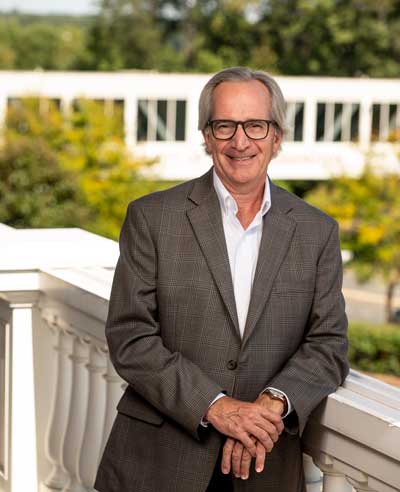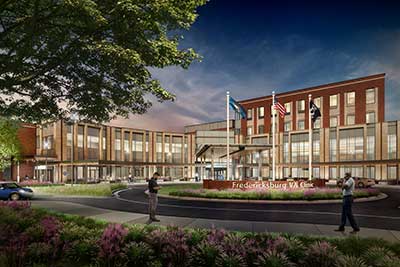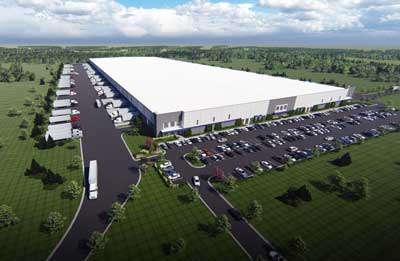Getting off the road
Fredericksburg area producing more jobs, reducing commutes
Gary Robertson //October 28, 2021//
Getting off the road
Fredericksburg area producing more jobs, reducing commutes
Gary Robertson //October 28, 2021//
For years, residents in the Fredericksburg region looked north for opportunity and higher-paying jobs.
But more homegrown jobs and remote work are signs of change for the area, says Curry Roberts, president of the Fredericksburg Regional Alliance, which includes Fredericksburg and the counties of Caroline, King George, Spotsylvania and Stafford. “We’re developing a distinct economy from Northern Virginia,” he says, including jobs with similar pay.
A few years ago, Amit Kapoor, president and CEO of First Line Technology, was looking for property to expand his emergency response equipment manufacturing business in Northern Virginia. Founded 18 years ago, First Line was based in Chantilly, near Dulles International Airport.
Priced out of Fairfax and Arlington counties, “we started looking at Prince William and Stafford,” and landed on a 24,000-square-foot facility in Stafford, where the company expanded in fall 2019.
Kapoor says that many of his 25 employees had long commutes to Chantilly, including First Line’s head of operations, who lives in King George County and often spent up to two hours on the road each day. “She was exhausted,” he says, and the move to Stafford has helped her and other employees reclaim their time. “Just the savings in money, the savings in time, the toll on your car. It also improves their time in the office.”
Also, he notes, purchasing property in Stafford saved the company about 50% compared with buying in Fairfax or Arlington, and First Line is able to pay everyone at the same salary level, no matter where they work. “We put a commitment on hiring folks from the Fredericksburg region,” says Kapoor, who splits his time between Chantilly and Stafford. “It’s been incredibly successful.”
Commuting from Fredericksburg to Northern Virginia or Washington, D.C., has largely been driven by economics, a 2019 commuter study indicated. People who commute north from Fredericksburg earn a median paycheck of $80,000, compared with $50,000 for those who work locally, according to the study by the University of Mary Washington, the Fredericksburg Regional Chamber of Commerce and the alliance.
The number of people commuting outside the region also rose — from 37% in 2013 to 42% in 2019. However, notes Roberts, the number of local jobs has grown in that time. “In 2019 and for the four years prior, we were in the top three [regions in the state] for job growth per capita, [according to the Virginia Economic Development Partnership]. In 2019, we were first.”

Over the past decade, the largest localities in the alliance have also seen solid demographic gains.
Fredericksburg’s population jumped by more than 18%, from 24,286 in 2010 to an estimated 28,766 in 2020, and Spotsylvania’s population rose 11% during that time to
140,032, according to the U.S. Census. Meanwhile, Stafford County‘s population surged more than 20% to 156,927 in 2020.
As a whole, the region has a dynamic and ready workforce to meet employers’ needs, says Roberts, who served as the state’s secretary of economic development under Gov. Gerald Baliles.
In 2019 the region’s workforce participation rate — the number of people either working or actively seeking jobs — was pegged at 68.9%, which Roberts says was 3.4 points higher than the state average.
The state’s workforce participation rate dropped to 62.9% in August, reflecting the nation’s labor shortage, so Roberts estimates the Fredericksburg region’s rate to be about 66% for the month.
Companies and site consultants some-times view the region as being part of Northern Virginia — but that’s not the whole story, Roberts says. Land costs and taxes are significantly lower in the Fredericksburg area, with per capita local taxes averaging $1,639, compared with $2,978 in Northern Virginia, according to data compiled by the alliance.
Buying property south of Fairfax, Kapoor says he found land prices decreased by about 20%. He says First Line will still maintain a presence in Fairfax, but Stafford will be its primary facility.
Here are some of the other major economic development projects taking place around the area:
One of the biggest new employers coming to the region is a U.S. Department of Veterans Affairs outpatient clinic on a 48-acre site along U.S. Route 1. The VA expects to hire more than 300 people when construction is completed in 2023. Employment is projected to grow to 550 by 2026.
Kevin Marshall, Spotsylvania’s business development manager, says the economic ripple effects of the four-story, 450,000-square-foot clinic will energize everything from hotel development to nursing programs at local colleges.
“It’s a big win,” Marshall says.
But Marshall and Debbie Sanders, the county’s interim economic development director, hasten to point out that the clinic is not the only headline project for the county, which also is the site of the largest solar energy project east of the Rockies.
That’s particularly relevant these days, with the Biden administration’s recently announced goal that solar energy should make up nearly 45% of U.S. electricity by 2050 and the Virginia Clean Economy Act’s 100% carbon-free electric production goal for the same year.
The 620-megawatt Spotsylvania Solar Energy Center is currently under construction and will encompass about 6,350 acres. Approximately 3,500 acres will be developed as part of the solar project and about 2,000 acres will be remain undeveloped.
About 800 temporary construction jobs are expected to be generated by the project, but only 35 permanent positions. Meanwhile, the economic development office remains on overdrive.
“We’re not slowing down,” Marshall says. “Last year, we opened up 200 new businesses.”

Stafford County
When he became Stafford’s economic development director in 2018, John Holden had a revelation: “One of the first things we did was to restructure and reposition some things that put us in position to attract a number of distribution and warehouse projects,” he says. “I knew that market was expanding and Stafford’s geographic position [along Interstate 95] … was pretty much designed for that kind of product.”
It’s worked out pretty well. In 2020, DHL Supply Chain invested $72 million to establish a distribution center in Stafford, yielding about 600 jobs. In September, Amazon.com Inc. announced that it would open a 200,000-square-foot delivery station, creating 100 jobs.
“Within the last three years, there will be permitted or built 2.5 million square feet of flex industrial/ distribution space in Stafford,” Holden says.
On another economic development front, there has been long been talk of creating a “Downtown Stafford,” but the original vision has recently changed from the idea of a conventional downtown to something much more high tech.
Working in conjunction with the Center for Innovative Technology, Stafford is the site of Virginia’s first Smart Community Testbed, an initiative for testing new technologies in a real world setting.
Plugged by state officials as a “living laboratory for entrepreneurs,” pilot projects will focus on public safety, data security and training, economic development and tourism, as well as 5G technology. McLean-based OST Inc., a systems integrator that works on local, state and federal government projects, is a founding partner and will integrate the testbed’s projects.
Holden suggests that the development of a “smart city” model could be a big step in further diversifying the county’s economy as new technologies emerge.

Fredericksburg
Among area localities, the city of Fredericksburg is the only one that has more workers commuting into the city than going out. Bill Freehling, the city’s economic development and tourism director, is proud of that.
But he also points to a number of big projects that have been in the works and are now completed or close to being finished.
One is the $90 million redevelopment of what used to be The Free Lance-Star newspaper’s headquarters, a 4-acre property that is being completely transformed into class A office space, along with new restaurants, residences and a hotel.
“People are interested in class A office space downtown,” Freehling says. Downtown Fredericksburg is eminently walkable, he says, with opportunities to stroll down to the Rappahannock River, which runs through the city, or to just duck into a nearby restaurant.
Another measure of pride for the city is its fielding of a Minor League Baseball team, the Fredericksburg Nationals (aka Fred Nats), which has a 5,000-seat stadium and attracts fans from throughout the region. The team debuted in 2021 after a one-year delay due to the pandemic.
Caroline has been having what economic development director Gary Wilson calls “a banner year.” Taking advantage of a surge in distribution centers along I-95, Wilson says the county recently rezoned land in Ruther Glen for a 1.1 million-square-foot speculative distribution center facility named Caroline 95 Logistics. It’s set to be available in the third quarter of 2022.
“It’s huge for us,” Wilson says.
On top of that, another developer also has plans to build an additional million-square-foot distribution center space.
In May, M.C. Dean Inc. broke ground on an 84,000-square-foot modular manufacturing and systems integration facility at its Center for Innovation and Industry in Caroline. The groundbreaking marks the second phase of a $25 million expansion announced in 2019, expected to create 100 jobs.
Headquartered in Tysons, M.C. Dean has a product line that focuses on large-scale, fully-integrated, modularized power, electronic security and telecom systems and rooms that are pre-commissioned before being transported to project and construction sites across the nation.

King George County
The convergence of three major projects in 2023 could change the face and future of King George’s nearly 27,000 residents.
Nick Minor, the county’s economic development and tourism director, cites broadband expansion, a $750 million four-lane bridge (replacing an existing two-lane structure) that will connect King George with Charles County, Maryland, and zoning updates that will open the way for more industry.
Also, there is the rapid evolution of the Naval Surface Warfare Center at Dahlgren into a digital proving ground for artificial intelligence, quantum computing and other technology areas that will be critical to the future of modern warfare. That in turn could provide new opportunities for technology transfer into commercial uses, and better paying jobs in the county.
With important changes on the horizon, Minor has high expectations about the future: “We can’t move quick enough.”
n
















